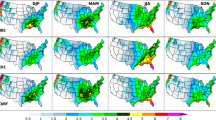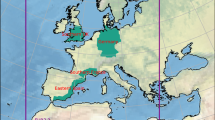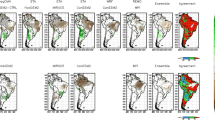Abstract
We present an analysis of extreme precipitation events in convection-resolving climate simulations. The simulations are performed with the COSMO-CLM model at 2.2 km resolution across an extended Alpine region and its larger-scale surrounding. Generalized extreme value theory (GEV) is applied to address projections of 5-day, daily and hourly extreme precipitation events in all seasons. Validation using ERA-Interim driven simulations reveals significant improvements with the 2.2 km resolution. In comparison to its driving 12 km model, high resolution improves the simulation of precipitation on most investigated timescales and seasons. The climate change signal is analyzed in 10-year long control and scenario simulations (1991–2000 and 2081–2090) driven by a CMIP5 coupled climate model (MPI-ESM-LR) under an RCP8.5 greenhouse gas scenario. Analysis shows negligible differences between the two resolutions for winter precipitation on all time scales, while in the other seasons the 2.2 km model shows smaller changes in extreme hourly precipitation, and yields narrower uncertainty estimates. Changes in extreme summer precipitation qualitatively scale with the Clausius–Clapeyron rate, i.e., 6–7% per degree warming, and are consistent with previous percentile based analysis. In winter, changes exceed the Clausius–Clapeyron rate. Some interpretations of this result are provided.









Similar content being viewed by others
References
Allen MR, Ingram WJ (2002) Constraints on future changes in climate and the hydrologic cycle. Nature 419:224–232. https://doi.org/10.1038/nature01092
Ban N, Schmidli J, Schär C (2014) Evaluation of the convection-resolving regional climate modeling approach in decade-long simulations. J Geophys Res Atmos 119:7889–7907. https://doi.org/10.1002/2014JD021478
Ban N, Schmidli J, Schär C (2015) Heavy precipitation in a changing climate: does short-term precipitation increase faster? Geophys Res Lett 42(4):1165–1172. https://doi.org/10.1002/2014GL062588
Berg P, Moseley C, Haerter JO (2013) Strong increase in convective precipitation in response to higher temperatures. Nat Geosci 6:181–185
Brockhaus P, Lüthi D, Schär C (2008) Aspects of the diurnal cycle in a regional climate model. Meteorol Z 17:433–443
Chan SC, Kendon EJ, Fowler HJ, Blenkinsop S, Roberts NM (2014a) Projected increase in summer and winter UK sub-daily precipitation extremes from high-resolution regional climate models. Environ Res Lett 9(084):019
Chan SC, Kendon EJ, Fowler HJ, Blenkinsop S, Roberts NM, Ferro CAT (2014b) The value of high-resolution met office regional climate models in the simulation of multihourly precipitation extremes. J Clim 27(16):6155–6174
Chan SC, Kendon EJ, Roberts NM, Fowler HJ, Blenkinsop S (2015) Downturn in scaling of uk extreme rainfall with temperature for future hottest days. Nat Geosci 9:24–28. https://doi.org/10.1038/ngeo2596
Christensen JH, Christensen OB (2003) Climate modelling: severe summertime flooding in Europe. Nature 421:805–806. https://doi.org/10.1038/421805a
Christensen JH, Christensen OB (2007) A summary of the PRUDENCE model projection of changes in European climate by the end of this century. Clim Change 81:7–30
Coles S (2001) An introduction to statistical modeling of extreme values. Springer, Berlin
Coles S, Pericchi L (2003) Anticipating catastrophes through extreme value modelling. J R Stat Soc Ser C (Appl Stat) 52(4):405–416. https://doi.org/10.1111/1467-9876.00413
Collins M, Knutti R (2013) Long-term climate change: projections, commitments and irreversibility. Chapter 12: Climate change, 2013. In: Contribution of working group 1 to the fifth assessment report of the intergovernmental panel on climate change. Cambridge University Press, Cambridge, pp 1029–1136
Dee DP, Uppala SM, Simmons AJ, Berrisford P, Poli P, Kobayashi S, Andrae U, Balmaseda MA, Balsamo G, Bauer P, Bechtold P, Beljaars ACM, van de Berg L, Bidlot J, Bormann N, Delsol C, Dragani R, Fuentes M, Geer AJ, Haimberger L, Healy SB, Hersbach H, Hólm EV, Isaksen L, Kallberg P, Köhler M, Matricardi M, McNally AP, Monge-Sanz BM, Morcrette J, Park BK, Peubey C, de Rosnay P, Tavolato C, Thépaut J, Vitart F (2011) The ERA-Interim reanalysis: configuration and performance of the data assimilation system. Q J R Meteorol Soc 137(656):553–597
Fischer EM, Knutti R (2016) Observed heavy precipitation increase confirms theory and early models. Nat Clim Change 6(11):986–991. https://doi.org/10.1038/nclimate3110
Fosser G, Khodayar S, Berg P (2016) Climate change in the next 30 years: what can a convection-permitting model tell us that we did not already know? Clim Dyn. https://doi.org/10.1007/s00382-016-3186-4
Frei C, Schär C (1998) A precipitation climatology of the Alps from high-resolution rain-gauge observations. Int J Climatol 18:873–900
Frei C, Schöll R, Fukutome S, Schmidli J, Vidale P (2006) Future change of precipitation in Europe: intercomparison of scenarios from regional climate models. J Geophys Res. https://doi.org/10.1029/2005JD005965
Fuhrer O, Chadha T, Hoefler T, Kwasniewski G, Lapillonne X, Leutwyler D, Lüthi D, Osuna C, Schär C, Schulthess TC, Vogt H (2017) Near-global climate simulation at 1 km resolution: establishing a performance baseline on 4888 GPUs with COSMO 5.0. Geosci Model Dev Discuss 2017:1–27. https://doi.org/10.5194/gmd-2017-230
Haerter JO, Berg P (2009) Unexpected rise in extreme precipitation caused by a shift in rain type? Nat Geosci 2:372–373
IPCC (2012) Managing the risks of extreme events and disasters to advance climate change adaptation. In: Field CB, Barros V, Stocker TF, Qin D, Dokken DJ, Ebi KL, Mastrandrea MD, Mach KJ, Plattner G-K, Allen SK, Tignor M (eds) A special report of Working Groups I and II of the Intergovernmental Panel on Climate Change. Cambridge University Press, Cambridge
IPCC (2013) Climate change 2013: the physical science basis. In: Stocker TF, Qin D, Plattner G-K, Tignor M, Allen SK, Boschung J, Nauels A, Xia Y, Bex V, Midgley PM (eds) Contribution of Working Group I to the fifth assessment report of the intergovernmental panel on climate change. Cambridge University Press, Cambridge
Isotta F, Frei C, Weilguni V, Tadić MP, Lasségues P, Rudolf B, Pavan V, Cacciamani C, Antolini G, Ratto SM, Munari M, Micheletti S, Bonati V, Lussana C, Ronchi C, Panettieri E, Marigo G, Vertačnik G (2014) The climate of daily precipitation in the Alps: development and analysis of a high-resolution grid dataset from pan-Alpine rain-gauge data. Int J Climatol 34(5):1657–1675. https://doi.org/10.1002/joc.3794
Katz RW, Parlange MB, Naveau P (2002) Statistics of extremes in hydrology. Adv Water Resour 25:1287–1304
Kaufmann P (2008) Association of surface stations to NWP model grid points. COSMO Newslett 9:2
Keller M (2016) The diurnal cycle of Alpine summer convection in a convection-resolving model: evaluation with satellite data and sensitivity to atmospheric forcing. PhD thesis, ETH Zürich, Zürich, Switzerland
Kendon EJ, Roberts NM, Senior CA, Roberts MJ (2012) Realism of rainfall in a very high-resolution regional climate model. J Clim 25(17):5791–5806. https://doi.org/10.1175/JCLI-D-11-00562.1
Kendon EJ, Roberts NM, Fowler HJ, Roberts MJ, Chan SC, Senior CA (2014) Heavier summer downpours with climate change revealed by weather forecast resolution model. Nate Clim Change 4:570–576. https://doi.org/10.1038/nclimate2258
Kendon EJ, Ban N, Roberts NM, Fowler HJ, Roberts MJ, Chan SC, Evans JP, Fosser G, Wilkinson JM (2017) Do convection-permitting regional climate models improve projections of future precipitation change? Bull Am Meteorol Soc 98(1):79–93. https://doi.org/10.1175/BAMS-D-15-0004.1
Kharin VV, Zwiers FW, Zhang X, Hegerl GC (2007) Changes in temperature and precipitation extremes in the IPCC ensemble of global coupled model simulations. J Clim 20(8):1419–1444. https://doi.org/10.1175/JCLI4066.1
Knote C, Heinemann G, Rockel B (2010) Changes in weather extremes: assessment of return values using high-resolution climate simulations at convection-resolving scale. Meteorol Z 19:11–23
Langhans W, Schmidli J, Schär C (2012) Bulk convergence of cloud-resolving simulations of moist convection over complex terrain. J Atmos Sci 69:2207–2228
Langhans W, Schmidli J, Bieri S, Fuhrer O, Schär C (2013) Long-term simulations of thermally driven flows and orographic convection at convection-parameterizing and cloud-resolving resolutions. J Appl Clim and Meteorol 52:1490–1510
Lenderink G, van Meijgaard E (2008) Increase in hourly precipitation extremes beyond expectations from temperature changes. Nat Geosci 1:511–514
Leutwyler D, Fuhrer O, Lapillonne X, Lüthi D, Schär C (2016) Towards European-scale convection-resolving climate simulations. Geosci Model Dev Discuss. https://doi.org/10.5194/gmd-2016-119
Leutwyler D, Lüthi D, Ban N, Fuhrer O, Schär C (2017) Evaluation of the convection-resolving climate modeling approach on continental scales. J Geophys Res Atmos. https://doi.org/10.1002/2016JD026013
Liu C, Ikeda K, Rasmussen R, Barlage M, Newman AJ, Prein AF, Chen F, Chen L, Clark M, Dai A, Dudhia J, Eidhammer T, Gochis D, Gutmann E, Kurkute S, Li Y, Thompson G, Yates D (2016) Continental-scale convection-permitting modeling of the current and future climate of North America. Clim Dyn. https://doi.org/10.1007/s00382-016-3327-9
Loriaux JM, Lenderink G, de Roode AR, Siebesma AP (2013) Understanding convective extreme precipitation scaling using observations and an entraining plume model. J Atmos Sci 70:3641–3655
Martins ES, Stedinger JR (2000) Generalized maximum-likelihood generalized extreme-value quantile estimators for hydrologic data. Water Resour Res 36:737–744
Molnar P, Fatichi S, Gaál L, Szolgay J, Burlando P (2015) Storm type effects on super Clausius–Clapeyron scaling of intense rainstorm properties with air temperature. Hydrol Earth Syst Sci 19:1753–1766. https://doi.org/10.5194/hess-19-1753-2015
Moseley C, Hohenegger C, Berg P, Haerter JO (2016) Intensification of convective extremes driven by cloud–cloud interaction. Nat Geosci 9:748–752. https://doi.org/10.1038/ngeo2789
Muller CJ, O’Gorman PA, Back LE (2011) Intensification of precipitation extremes with warming in a cloud resolving model. J Clim 24:2784–2800
Nasuno T, Yamada H, Nakano M, Kubota H, Sawada M, Yoshida R (2016) Global cloud-permitting simulations of Typhoon Fengshen (2008). Geosci Lett 3(1):32
O’Gorman PA, Schneider T (2009) Scaling of precipitation extremes over a wide range of climates simulated with an idealized GCM. J Clim 22:5676–5685
Pall P, Allen MR, Stone DA (2007) Testing the Clausius–Clapeyron constraint on changes in extreme precipitation under CO\(_2\) warming. Clim Dyn 28:351–363
Panosetti D, Schlemmer L, Schär C (2018) Convergence behavior of idealized convection-resolving simulations of summertime deep moist convection over land. Clim Dyn. https://doi.org/10.1007/s00382-018-4229-9
Prein AF, Gobiet A (2016) Impacts of uncertainties in European gridded precipitation observations on regional climate analysis. Int J Climatol 37(1):305–327. https://doi.org/10.1002/joc.4706
Prein AF, Gobiet A, Suklitsch M, Truhetz H, Awan NK, Keuler K, Georgievski G (2013) Added value of convection permitting seasonal simulations. Clim Dyn 41(9–10):2655–2677. https://doi.org/10.1007/s00382-013-1744-6
Prein AF, Langhans W, Fosser G, Ferrone A, Ban N, Goergen K, Keller M, Tölle M, Gutjahr O, Feser F, Brisson E, Kollet S, Schmidli J, van Lipzig NPM, Leung R (2015) A review on regional convection-permitting climate modeling: demonstrations, prospects, and challenges. Rev Geophys 53(2):323–361. https://doi.org/10.1002/2014RG000475
Prein AF, Rasmussen RM, Ikeda K, Liu C, Clark MP, Holland GJ (2016) The future intensification of hourly precipitation extremes. Nat Clim Change 7:48–52. https://doi.org/10.1038/nclimate3168
Rajczak J, Schär C (2017) Projections of future precipitation extremes over Europe: a multi-model assessment of climate simulations. J Geophys Res Atmos 122:10,773–10,800. https://doi.org/10.1002/2017JD027176
Rajczak J, Pall P, Schär C (2013) Projections of extreme precipitation events in regional climate simulations for Europe and the Alpine region. J Geophys Res Atmos 118:3610–3626. https://doi.org/10.1002/jgrd.50297
Rasmussen R, Liu C, Ikeda K, Gochis D, Yates D, Chen F, Tewari M, Barlage M, Dudhia J, Yu W, Miller K, Arsenault K, Grubišić V, Thompson G, Gutmann E (2011) High-resolution coupled climate runoff simulations of seasonal snowfall over colorado: a process study of current and warmer climate. J Clim 24:3015–3048. https://doi.org/10.1175/2010JCLI3985.1
Romps DM (2011) Response of tropical precipitation to global warming. J Atmos Sci 68:123–138
Schär C, Ban N, Fischer EM, Rajczak J, Schmidli J, Frei C, Giorgi F, Karl TR, Kendon EJ, Tank AMGK, O’Gorman PA, Sillmann J, Zhang X, Zwiers FW (2016) Percentile indices for assessing changes in heavy precipitation events. Clim Change 137(1):201–216. https://doi.org/10.1007/s10584-016-1669-2
Scherrer SC, Fischer EM, Posselt R, Liniger MA, Croci-Maspoli M, Knutti R (2016) Emerging trends in heavy precipitation and hot temperature extremes in Switzerland. J Geophys Res Atmos 121(6):2626–2637. https://doi.org/10.1002/2015JD024634
Schlemmer L, Schär C, Lüthi D, Strebel L (2018) A groundwater and runoff formulation for weather and climate models. J Adv Mod Earth Syst. https://doi.org/10.1029/2017MS001260
Sevruk B (1985) Correction of precipitation measurements. In: Proceedings of workshop on the correction of precipitation measurements, Zürich, Switzerland, WMO/IAHS/ETH, pp 13–13
Solari S, Losada MA (2012) A unified statistical model for hydrological variables including the selection of threshold for the peak over threshold method. Water Res. https://doi.org/10.1029/2011WR011475
Steppeler J, Doms G, Schattler U, Bitzer H, Gassmann A, Damrath U, Gregoric G (2003) Meso-gamma scale forecasts using the nonhydrostatic model LM. Meteorol Atmos Phys 82:75–96
Stevens B, Giorgetta M, Esch M, Mauritsen T, Crueger T, Rast S, Salzmann M, Schmidt H, Bader J, Block K, Brokopf R, Fast I, Kinne S, Kornblueh L, Lohmann U, Pincus R, Reichler T, Roeckner E (2013) Atmospheric component of the MPI-M earth system model: ECHAM6. J Adv Model Earth Syst 5:146–172
Thompson P, Cai Y, Reeve D, Stander D (2009) Automated threshold selection methods for extreme wave analysis. Coast Eng 56:1013–1021
Trenberth KE (1999) Conceptual framework for changes of extreme of the hydrological cycle with climate chnage. Clim Change 42:327–339
Wang G, Wang D, Trenberth KE, Erfanian A, Yu M, Bosilovich MG, Parr DT (2017) The peak structure and future changes of the relationships between extreme precipitation and temperature. Nat Clim Change 7:268–274. https://doi.org/10.1038/nclimate3239
Wilks DS (2011) Statistical methods in the atmospheric sciences. Academic Press, San Diego
Zhang X, Zwiers F, Li G, Wan H, Cannon A (2017) Complexity in estimating past and future extreme short-duration rainfall. Nat Geosci 10(4):255–259
Acknowledgements
Funding for this study was provided by the Swiss National Sciences Foundation through the Grant 200021_132614 and the Sinergia Grant CRSII2_154486 ‘crCLIM’. Juerg Schmidli was partly supported by the Hans Ertel Centre for Weather Research. The numerical simulations were conducted on the CRAY XE6 at the Swiss National Supercomputing Center (CSCS) in Lugano, with partial support from PRACE. The authors would like to thank MeteoSwiss, for providing us with observational data set (EURO4M-APGD and ANETZ data), and for the support in setting-up and running the simulations. Furthermore, we acknowledge the European Center for Medium Range Weather Forecast (ECMWF, Reading, UK) for providing access to ERA-Interim reanalysis and Max-Planck Institute (Hamburg) for providing boundary data from the global climate model MPI-ESM-LR. The extreme value analysis has been done using an R package “gevXgpd” provided by Christoph Frei. The authors would also like to thank Dani Lüthi (ETH Zürich) and Lukas Egloff for input and useful comments.
Author information
Authors and Affiliations
Corresponding author
Additional information
This paper is a contribution to the special issue on Advances in Convection-Permitting Climate Modeling, consisting of papers that focus on the evaluation, climate change assessment, and feedback processes in kilometer-scale simulations and observations. The special issue is coordinated by Christopher L. Castro, Justin R. Minder, and Andreas F. Prein.
Electronic supplementary material
Below is the link to the electronic supplementary material.
Rights and permissions
About this article
Cite this article
Ban, N., Rajczak, J., Schmidli, J. et al. Analysis of Alpine precipitation extremes using generalized extreme value theory in convection-resolving climate simulations. Clim Dyn 55, 61–75 (2020). https://doi.org/10.1007/s00382-018-4339-4
Received:
Accepted:
Published:
Issue Date:
DOI: https://doi.org/10.1007/s00382-018-4339-4




